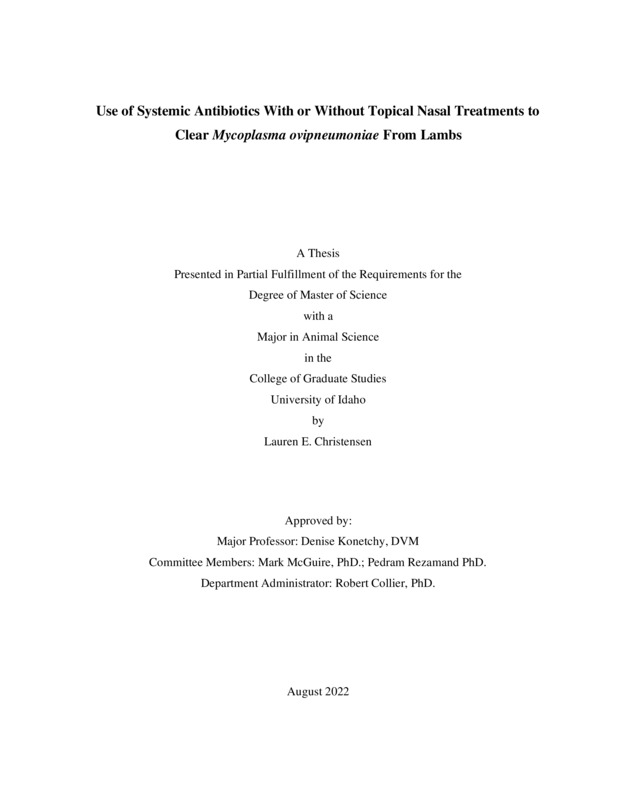Use of Systemic Antibiotics With or Without Topical Nasal Treatments to Clear Mycoplasma ovipneumoniae From Lambs
Christensen, Lauren. (2022-08). Use of Systemic Antibiotics With or Without Topical Nasal Treatments to Clear Mycoplasma ovipneumoniae From Lambs. Theses and Dissertations Collection, University of Idaho Library Digital Collections. https://www.lib.uidaho.edu/digital/etd/items/christensen_idaho_0089n_12445.html
- Title:
- Use of Systemic Antibiotics With or Without Topical Nasal Treatments to Clear Mycoplasma ovipneumoniae From Lambs
- Author:
- Christensen, Lauren
- Date:
- 2022-08
- Keywords:
- antibiotic lamb mycoplasma mycoplasma ovipneumoniae sheep
- Program:
- Animal, Vet & Food Sciences
- Subject Category:
- Animal diseases; Animal sciences
- Abstract:
-
Mycoplasma ovipneumoniae (M. ovipneumoniae) is often carried asymptomatically in the nasal passages of domestic small ruminants worldwide and is commonly associated with chronic respiratory disease. Currently, no antibiotics are labeled for treatment of this bacterium in domestic sheep in the United States. The efficacy of systemic antibiotics with or without nasal flush treatments to clear M. ovipneumoniae in lambs was assessed. The study was conducted in two parts, Cohort I in 2021 and Cohort II in 2022. Yearling Suffolk lambs were identified as positive for M. ovipneumoniae via nasal swab PCR, randomly assigned to different treatments and a positive control group (n=6 animals per group). Pens were spaced 2.9 meters apart during the study. Treatments in Cohort I were as follows: oxytetracycline 20 mg/kg subcutaneously (SQ) once (OXO); oxytetracycline 10 mg/kg intramuscularly (IM) once daily for 5 d (OXD); oxytetracycline 10 mg/kg IM daily for 5 d with a dilute betadine nasal flush daily for 5 d (OXB); oxytetracycline 10 mg/kg IM daily for 5 d with a dilute chlorhexidine nasal flush daily for 5 d (OXC); and positive control receiving no treatment (POS ). In Cohort II, treatments were as follows: lincomycin 5 mg/kg IM every 48 h for 3 doses (LIN); lincomycin 5 mg/kg IM every 48 h for 3 doses with dilute lincomycin nasal flush daily for 5 d (LIF); florfenicol 20 mg/kg IM every 48 h for 3 doses (FLO); florfenicol 20 mg/kg IM every 48 h for 3 doses with dilute florfenicol nasal flush daily for 5 d (FLF); oxytetracycline 10 mg/kg IM daily for 5 d (OXD); and positive control receiving no treatment (POS). Treatment efficacy was evaluated by nasal swab PCR obtained at days 7, 14, 21 and 28 post treatment. Statistical analysis was performed using non-linear mixed effects modeling in R. Response to treatment was evaluated by comparing mean PCR Ct values of each treatment to the Ct values of the POS groups over time, with Ct values classified as ‘Detected’ (Ct ≤36), ‘Indeterminate’ (Ct 36-40), or ‘Not Detected’ (Ct ≥40). In comparison to the Ct values of the POS groups, OXD was the only treatment found to increase (P = 0.003) Ct values overall, indicating a decrease in M. ovipneumoniae genomic material. OXD compared to POS was (P = 0.004) different on d 7, d 14 (P = 0.0005), and d 21 (P = 0.008), but not on d 28 (P = 0.52). Mean Ct values of OXD groups were 31.4 over the course of the study, while mean Ct values of POS groups were 25.3. Ct values of the OXD group decreased over time (d 7= 35.7, d 28=29.6). The OXB group was significant in increasing Ct value compared to the POS groups only on Day 7 (P = 0.034). All other groups showed no detectable response to treatment in comparison to the POS groups overall, nor at any point in time. Although OXD increased Ct values when compared to POS, it did not induce complete response to treatment by achieving Ct values ≥40 in the majority of animals, nor were the Ct values maintained over time. We suspect the decreasing Ct values over the course of the study were related to the animals being re-infected with M. ovipneumoniae because of prolonged exposure to positive group members that did not respond to treatment. Failure to respond to treatment can likely be attributed to variations in M. ovipneumoniae strain type susceptibility and virulence. Complete response to treatment in the majority of the study animals is needed in order to recommend the antibiotic be used to treat animals with clinical disease. Further studies identifying the strain types present in a study cohort, and testing and segregating animals after treatment to prevent re-infection from a positive cohort is warranted.
- Description:
- masters, M.S., Animal, Vet & Food Sciences -- University of Idaho - College of Graduate Studies, 2022-08
- Major Professor:
- Konetchy, Denise
- Committee:
- McGuire, Mark; Rezamand, Pedram; Collier, Robert
- Defense Date:
- 2022-08
- Identifier:
- Christensen_idaho_0089N_12445
- Type:
- Text
- Format Original:
- Format:
- application/pdf
- Rights:
- In Copyright - Educational Use Permitted. For more information, please contact University of Idaho Library Special Collections and Archives Department at libspec@uidaho.edu.
- Standardized Rights:
- http://rightsstatements.org/vocab/InC-EDU/1.0/

